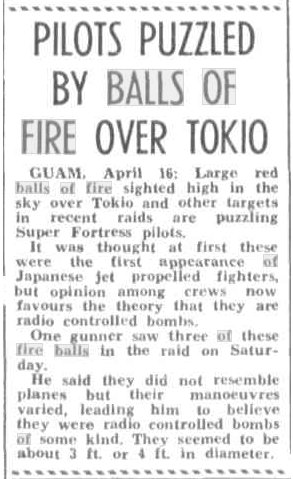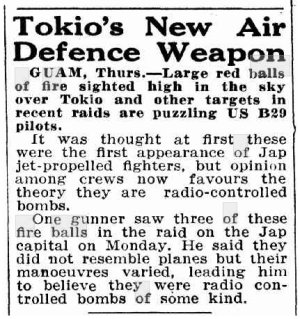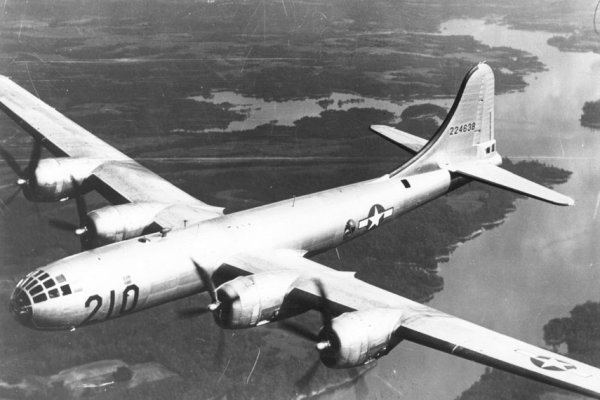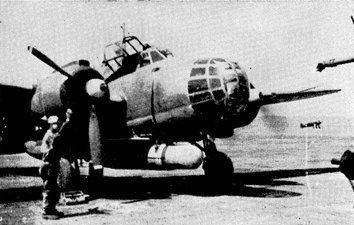ACUFO-1945-04-14-TOKYO-1
In the newspaper Guinea Gold, Papua - New-Guinea, for April 20, 1945, an article explained that it was reported from Guam that large red balls of fire sighted high in the sky over Tokyo and other targets in recent raids are puzzling the U.S. B29 pilots.
The newspaper indicated that it was thought at first these were the first appearance of Japanese jet-propelled fighters aircraft but opinion among the crews now favors the theory they are radio-controlled bombs.
The newspaper reported that one gunner saw three of these fire balls in the raid on Tokyo capital on April 14, 1945; he said that they did not resemble planes, but their maneuvres varied, leading him to believe they were radio-controlled bombs of some kind.
| Date: | April 14, 1945 |
|---|---|
| Time: | ? |
| Duration: | ? |
| First known report date: | April 20, 1945 |
| Reporting delay: | Hours. |
| Country: | Japan |
|---|---|
| State/Department: | Kanto |
| City or place: | Tokyo |
| Number of alleged witnesses: | 1 |
|---|---|
| Number of known witnesses: | 1 |
| Number of named witnesses: | 0 |
| Reporting channel: | The Press. |
|---|---|
| Visibility conditions: | ? |
| UFO observed: | Yes. |
| UFO arrival observed: | ? |
| UFO departure observed: | ? |
| UFO action: | Varied maneuvers. |
| Witnesses action: | |
| Photographs: | No. |
| Sketch(s) by witness(es): | No. |
| Sketch(es) approved by witness(es): | No. |
| Witness(es) feelings: | ? |
| Witnesses interpretation: | Rockets guided by radio. |
| Sensors: |
[X] Visual: 1 or more.
[ ] Airborne radar: [ ] Directional ground radar: [ ] Height finder ground radar: [ ] Photo: [ ] Film/video: [ ] EM Effects: [ ] Failures: [ ] Damages: |
|---|---|
| Hynek: | ? |
| Armed / unarmed: | Armed, 12 Browning M2 12,7 mm machine guns. |
| Reliability 1-3: | 2 |
| Strangeness 1-3: | 2 |
| ACUFO: | Insufficient information. |
[Ref. teh1:] NEWSPAPER "THE TELEGRAPH":

|
GUAM, April 16: Large red balls of fire sighted high in the sky over Tokio and other targets in recent raids are puzzling Super Fortress pilots.
It was thought at first these were the first appearance of Japanese jet propelled fighters, but opinion among crews now favours the theory that they are radio controlled bombs.
One gunner saw three of these fire balls in the raid on Saturday.
He said they did not resemble planes but their maneuvres varied, leading him to believe they were radio controlled bombs of some kind. They seemed to be about 3 ft. or 4 ft in diameter.
[Ref. gug1:] NEWSPAPER "GUINEA GOLD":

|
GUAM, Thurs. -- Large red balls of fire sighted high in the sky over Tokio and other targets in recent raids are puzzling US B29 pilots.
It was thought at first these were the first appearance of Jap jet-propelled fighters, but opinion among crews now favours the theory they are radio-controlled bombs.
One gunner saw three of these fire balls in the raid on the Jap capital on Monday. He said they did not resemble planes but their maneuvres varied, leading him to believe they were radio controlled bombs of some kind.
The Boeing B-29 “Superfortress” was the heaviest bomber of the U.S. Army Air Forces, used in operations from May 8, 1944 and on. Its maximum speed was 574 km/h.
Its defensive armament was 12 Browning M2 12.7 mm machine guns.

|

|
The information is obviously too meager to provide a firm explanation for this observation.
We can, however, say that there was an “escalation of hypotheses” regarding the “balls of fire”:
The first idea, that of Japanese jet planes, was justified at that time. The Nazis intended to share their technology with the Japanese, and the latter undertook to build jet planes based on the German Messerschmitt Me-262.
The Japanese undertook to build two different prototypes: the Nakajima Ki-201 «Karyu», the single prototype of which was never completed, and the Nakajima «Kikka», which did not complete a (failed) test flight of the only prototype until August 7, 1945, the day after the atomic bombing of Hiroshima.
The second idea, that of “radio-guided bombs”, cannot have appeared without reason in place of that of the jet fighters, and the reason was probably that the “balls of fire” very generally did not reveal any fuselage or wings - we see this in most reports.
The idea of radio guidance must have come from the fact that the “balls of fire” maneuvered intelligently; if this had not been the case one would have said they were unguided rockets.
The Japanese, like other belligerents, had undertaken to develop radio-guided missiles from mid-1944 on, such as the Mitsubishi 1A (aka Ki-147) and the Kawasaki 1B, both planned to be powered by a Mitsubishi rocket engine. They were planned to be dropped from Peggy and Lilly bombers (Below, a Lily with a 1-B missile).

|
The first problem is that none of these projects resulted in operational versions used for defense against U.S. aircraft. The Funryu, planned as a surface-to-air guided missile, was canceled before the end of the war, none having been able to be put into service, and only one having been tested on the ground, on August 16, 1945, the day after the surrender of Japan.
The first prototype of the Ki-147 was completed in October 1944, 10 missiles were ready in November 1944. It was then tested, but its stabilizer did not work, the radio equipment was unreliable, and it was not put into operation.
The Kawasaki I-Gо Model 1 Otsu, an air-to-ground guided missile, has not been put into service. The Yokosuka Naval Air Technical Arsenal's Ke-Go, a guided air-to-ground flying bomb, had failed its tests, and when the problems seemed to be resolved, the war finished.
The second problem is that for all these projects, the intended “maneuverability” was very limited, with simple radio commands, “up, down, left, right”, and “explode”, all supposed to be directed visually from the carrier aircraft or the ground. Most were air-to-ground missiles intended to strike ships, through detection of the infrared trace they would emit. None could have explained a “ball of fire” that followed a plane or flew in a circle around a plane. And it should be remembered that none of the “balls of fire” reported by American aviators in 1944-1945 in the Pacific theater had attacked their aircraft.
So the interpretation at the time made sense, but the post-war research showed that the Japanese had no ready weapons that could really match the “ball of fire” - I of course exclude the fact that some of the “least impressive” “balls of fire” were sometimes astronomical misinterpretations or burning planes, or unguided ground-to-air or air-air rockets, or planes equipped with searchlights that had been called “ball of fire.”
Insufficient information.
* = Source is available to me.
? = Source I am told about but could not get so far. Help needed.
| Main author: | Patrick Gross |
|---|---|
| Contributors: | None |
| Reviewers: | None |
| Editor: | Patrick Gross |
| Version: | Create/changed by: | Date: | Description: |
|---|---|---|---|
| 0.1 | Patrick Gross | July 13, 2024 | Creation, [gug1]. |
| 1.0 | Patrick Gross | July 13, 2024 | First published. |